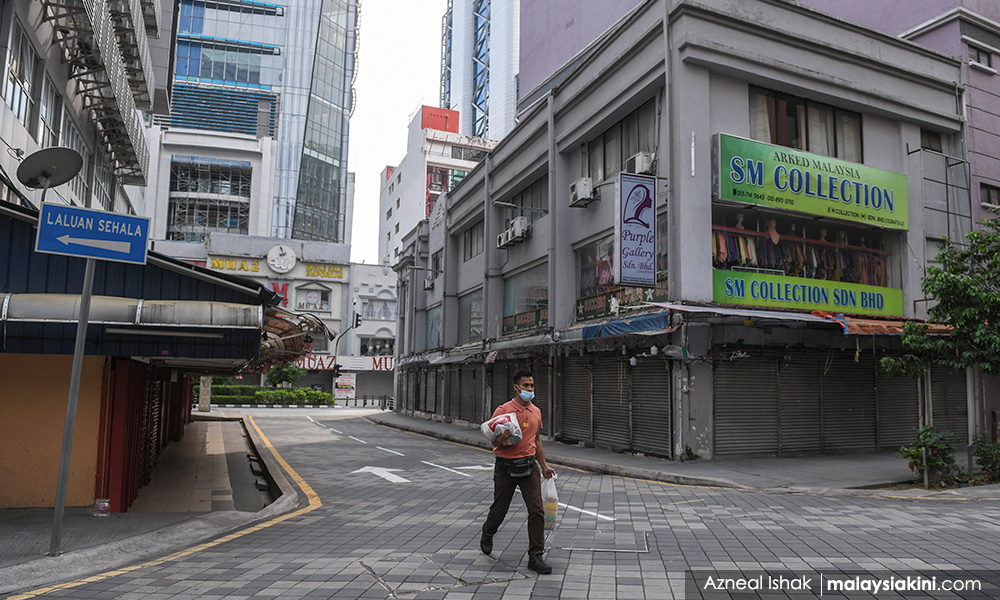LETTER | Given the long-term nature of the Covid-19 crisis, we urge the government to adopt a more sustainable strategy of dealing with the pandemic that would enable Malaysians to continue to make a living safely.
The government needs to reset its pandemic management approach, from the endless cycles of disruptive economic lockdowns to a more strategic detection and containment of cases to stem virus transmissions, while concurrently preparing for a gradual opening of economic and social sectors through smart use of technology and a change in the working environment.
The impact of a lockdown is uneven to businesses and adversely affects “non-essential sectors” that are prohibited from operating such as retail, hospitality, and services.
The SME Association of Malaysia has already estimated that 50,000 additional small and medium enterprises could be wiped out if the current lockdown were to continue beyond six weeks. This would cause more job losses that diminish people’s purchasing power which eventually threatens the survival of businesses that initially thrived during earlier lockdown phases.
The question now is - will we see the end of this "total lockdown" or "Full Movement Control Order" (FMCO) anytime soon? With only a few days till June 28, many of us are looking forward to an easing of restrictions as stipulated in Phase 2 of the four-phase Malaysia National Recovery Plan (NRP) that is slated to start in July.
However, we should not get our hopes up just yet. Since we have not met all three of the main thresholds below as outlined in the NRP, the full lockdown or “Phase 1” is expected to be extended potentially for another two weeks.
- Below 4,000 new daily cases (seven-day average) - we've had an average of 5,412 cases as at June 22
- Below 75 percent bed utilisation at intensive care units (ICUs) - we've had 94 percent as of June 15
- 10 percent population fully vaccinated - we've had 5.28 percent fully vaccinated as of June 22
Essentially, the NRP’s overreliance on nationwide movement restrictions and vaccinations will eventually trap us in a continuous lockdown. Not just that, even with a "full MCO" in place, workplace clusters continue to show no signs of subsiding, making up more than 65 percent of reported cases since June 1.
The UK’s experience with outbreak resurgence due to new variants also sheds light on how a country cannot guarantee it can open its economic and social sectors solely by vaccinating a majority of its population. An alternative exit strategy is sorely needed.

Reopening Economy
Factors contributing to workplace clusters must be addressed. Aside from enforcement, the government needs to assess if existing standard operating procedures (SOPs) are sufficient to prevent any outbreak at premises that could endanger the lives of employees and disrupt operations.
To encourage adoption, the government should assist employers with “pandemic-proofing” workspaces and living quarters through financial support.
Rather than a one-size-fits-all arbitrary metric of workplace capacities, SOPs should be science-based and dynamic — updated regularly with inputs from industry players, other stakeholders, and also data from the field.
But we could go even further. With scientific findings indicating that the Covid-19 virus is airborne, the government should focus on updating the SOPs to ensure business premises improve indoor air quality, thereby reducing transmission.
The most obvious action that could be taken is to incentivise, through tax deductions or subsidies, the installation of sensors and ventilation systems at workplaces.
The use of smart technology should also be promoted, such as automated doors, motion-sensor lights, or other ‘no-touch technology’ for switches and handles. This could reduce high traffic touchpoints and prevent hand-to-hand virus spread.
Changes in workspace design and culture can also help prevent transmission among co-workers. More individualised workspaces or ‘booths’, with greater spaces in between, instead of open-plan and cramped offices, can certainly limit cross-infection.

In addition, a rotation system with one week at the office and one week at home, or more flexible working hours and shifts, could be introduced to prevent big crowds. For the same purpose, operating hours for public transportation and other public spaces can be extended.
The same set of principles and thinking can be customised to ensure learning, retail, public, social, and living spaces are “pandemic proof”. These measures should be complemented with a comprehensive Find, Test and Trace, Isolate, Support and Vaccinate (FTTIS+V) framework led by the government.
It has become increasingly clear that lockdowns create too much collateral damage to be considered a viable long-term strategy. Individual businesses, households, employees, and ordinary Malaysians will continue to suffer if we continue taking this destructive path.
We must therefore dispel the false tradeoff between lives and livelihoods as health and economy are deeply intertwined. Instead, we should adopt a comprehensive pandemic mitigation strategy to restore people’s wellbeing and ensure their survival until we win this war against Covid-19.
BADRUL HISHAM ISMAIL is the Director of Programmes for Iman Research. RAJA AHMAD ISKANDAR FAREEZ is the Communications Director for Refsa.
The views expressed here are those of the author/contributor and do not necessarily represent the views of Malaysiakini.

